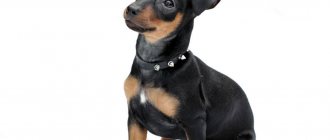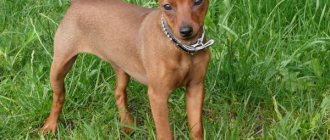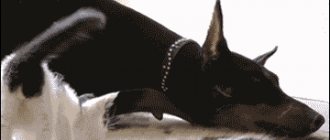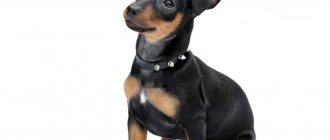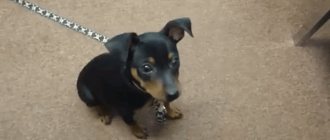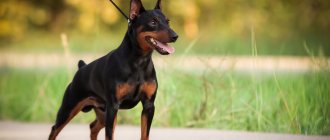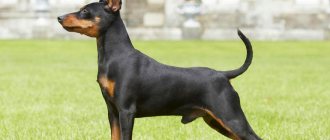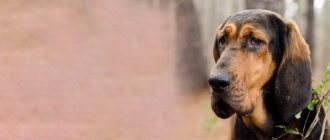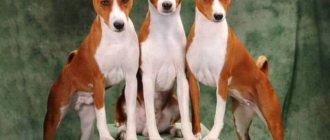pros
- Small size - can be carried and taken on trips
- Lively, cheerful disposition
- Can live in any home (from small apartments to large houses)
Minuses
- Barks a lot
- Wary of strangers and may become aggressive
- May feel threatened by young children
Originally from Germany, Miniature Pinscher is a small, robust dog with a lively and lovable personality.
Despite its small size, the miniature pinscher is a strong, athletic dog with the instinct of a hunter and watchman. It is prized for its unique "hired gait": almost trotting like a horse, it lifts its front legs up and out with a bend at the wrist. But, unlike a horse, the miniature pinscher trots only with its front legs, not its hind legs.
Characteristics of the Miniature Pinscher
| Attachment level | Average |
| Friendliness | High |
| Child Friendly | Average |
| Loyalty to other pets | Average |
| Exercise needs | High |
| Playfulness | High |
| Energy level | High |
| Learning ability | Average |
| Intelligence | High |
| Tendency to bark | High |
| Shedding amount | Low |
Miniature pinschers training in Moscow. Required commands:
Team "Come to me"
- if your dog knows how to carry out this command, then you can be sure that it will never get lost or run far in pursuit of another dog, cat or pigeon, but will return to you as soon as necessary.
Command "Stand"
- You will need it to protect your miniature pinscher from passing cars or an aggressive dog coming towards you.
Team "Fu"
- needed to wean the dog from picking up from the ground. In this case, your miniature pinscher may no longer be afraid of food poisoning.
Team "Nearby"
— you need to ensure that the dog does not pull on the leash and that walking together brings pleasure not only to your pet, but also to you.
Command "Sit"
- will come in handy when you need to leave him to wait for you, or simply while you are busy with something else.
Team "Quiet"
- useful if your pet likes to bark at noise outside the door or at passing people and dogs.
Team "Place"
— you need your pet not to distract you when doing chores around the house or greeting guests.
Our instructors will offer you a large number of interesting and, most importantly, useful commands during the first lesson when drawing up a training program for your dog.
Miniature Pinscher History
The Miniature Pinscher originated in Germany several centuries ago, where it was used to hunt rats on farms. It was first named Reh Pinscher because of its supposed resemblance to the reh, or small deer, that once lived in the forests of Germany.
This breed is believed to be descended from the German Standard Pinscher, just like the Doberman Pinscher. However, the Miniature Pinscher is not a purebred version of the Doberman, as it came earlier. Dachshunds and Italian greyhounds are also likely ancestors.
In 1895, German breeders formed the Pinscher Club, later renamed the Pinscher-Schnauzer Club, and the first breed standard was written. Miniature Pinschers were first shown at the Stuttgart Dog Show in 1900.
Between 1905 and World War I, the Miniature Pinscher's popularity grew in Germany. After World War I, breeders in Germany and the Scandinavian countries worked to improve the line.
Miniature Pinscher kennels
| Nurseries | Federation | City |
| Nursery VANDEBOR | RFSS | Moscow |
| Kennel “Joker Show” | OANKOO/Fauna | Moscow |
| Nursery Adular | RFLS | Moscow |
| Kennel Ice Black Pearl | OANKOO/Fauna | Sosnogorsk |
| Kennel Anlit Relines | RFLS | Saint Petersburg |
| Kennel APOL WEI | RFSS | Volzhsky |
| Nursery ARCTIC PARADISE | RFLS | Bryansk |
| Kennel Art Sympathy | RFLS | Podolsk |
| Kennel Blik Moskovii | OANKOO/Fauna | Lyubertsy |
| Kennel Bohai Talisman | RFOS | Vladivostok |
| Kennel Brand Natalie | OANKOO/Elite | Naro-Fominsk |
| Nursery WEINBERG | RFSS | Gulkevichi |
| Kennel Viento Victory | RFLS | Moscow |
| Kennel VIKKI CLAIR | RFLS | Chelyabinsk |
| Kennel WUNDER WOLF | RFSS | Ufa |
| Kennel Grand Mollis | RFLS | Saint Petersburg |
| Kennel Grant Britt | OANKOO/Fauna | Moscow |
| Kennel Ming Dynasty | RFSS | Chelyabinsk |
| Kennel Deep Mystery | RFOS | Petrozavodsk |
| Kennel Elitstar | RFLS | Moscow |
| Kennel Elitstar | RFLS | Moscow |
| Nursery PEARL OF THE EAST | RFSS | Vladivostok |
| Nursery Zvezda Gardariki | OANKOO/RKK | Moscow |
| Nursery from Galakun | RFLS | Moore |
| Nursery FROM HOUSE PARKIS | RFSS | Railway |
| Kennel IZ LIKINSKIKH | RFSS | Moscow |
| Nursery Irpoland | OANKOO/RKK | Moscow |
| Nursery Irhouse | RFLS | Arkhangelsk |
| Nursery Corventus | RFOS | Kashira |
| Kennel Carlin Bright from Tsarskoye Selo | RFSS | Saint Petersburg |
| Nursery LEEKUR | RFLS | Moscow |
| Nursery Malagris | RFOS | Moscow |
| Nursery NAGAZI | RFLS | Ekaterinburg |
| Nursery Our Mark | RFLS | Moscow |
| Nursery Nevsky Kristal | RFLS | Saint Petersburg |
| Nursery Oberlauf | RFSS | Saint Petersburg |
| Kennel Old Banditos | RFLS | Moscow |
| Kennel CHARMING/YY | RFSS | Vladivostok |
| Nursery Pride Kingdom | OANKOO/Fauna | Moscow |
| Kennel RUSSIAN VERSAILLES | RFLS | Moscow |
| Kennel S TANAIS | RFSS | Voronezh |
| Kennel SALTIGA STORY | OANKOO/Fauna | Odintsovo |
| Kennel SUNNY MANKEU | RFLS | Saint Petersburg |
| Kennel SANTA YULF | RFLS | Saint Petersburg |
| Nursery SLAVYANKA | OANKOO/Fauna | Dzerzhinsky |
| Kennel Solo Vision | RFLS | Saint Petersburg |
| Nursery Sursky souvenir | OANKOO/Elite | Penza |
| Nursery Talvish | OANKOO/Elite | Murmansk |
| Kennel SHADOW OF THE MOON | RFSS | Saratov |
| Nursery Tugan Yak | RFSS | Ufa |
| Nursery Udachny Vybor | RFSS | Samara |
| Kennel FAYTER | RFSS | Saint Petersburg |
| Kennel Fancy Wool | RFLS | Moscow |
| Kennel FIELISS | OANKOO/Fauna | Voronezh |
| Kennel VON NORD TRAUN | RFSS | Petrozavodsk |
| Kennel FRANNIE TAIL | RFLS | Saint Petersburg |
| Helen Hoff Nursery | RFLS | Korolev |
| Kennel CHERNAYA KALITVA | RFSS | Voronezh |
| Nursery Chantley Rose | RFLS | Artem |
| Nursery Schwarzen Wald | RFLS | Gatchina |
| Kennel Eria Pro | RFLS | Voronezh |
| Kennel Yankar Assortik | RFLS | Astrakhan |
| Nursery Yasnye Zori | RFLS | Moscow |
| Kennel BLACK STRANGER | RFLS | Saint Petersburg |
Source - https://rkf.online/organizations?organization_type=3&active_rkf_user=false&activated=false
For more information, see the official website of the RKF.
Miniature Pinscher Care
The Miniature Pinscher has erect ears that can be cropped and a tail that can be docked. The coat is smooth, shiny and very short. The breed simply requires basic care. His coat should be brushed weekly or more frequently to maintain a healthy, shiny appearance. This breed sheds quite a bit.
Miniature Pinschers are very active, energetic dogs that need a lot of exercise. This breed tends to be fearless and brave. Proper training is an absolute must for this dog.
He is quite intelligent and generally responds well to training. Without effective training, the breed can also become stubborn and unruly. In any case, the miniature pinscher is a quite suitable companion with a funny behavior.
The Miniature Pinscher's lively disposition and dynamic personality make him an excellent companion for the right home. With proper socialization, he can get along well with children if raised with them. Although the Miniature Pinscher can be an affectionate companion, it is not a lap dog and requires activity and attention.
Training a miniature pinscher puppy, when to start
Training a miniature pinscher puppy must begin from the very first days
the presence of a dog in your home. There is an opinion that puppies should be trained no earlier than 6 months, but this opinion is erroneous, although quite widespread. From infancy, you need to instill in your dog the rules of behavior in your home, what is allowed and what is prohibited.
Often new puppy owners worry that training from the first days will be excessively stressful for the dog. This is only possible if outdated, strict methods are used, but with the right approach, training from the first days will, on the contrary, be very useful, since it allows you to immediately establish contact with the puppy and build a trusting relationship.
You can also start practicing basic obedience commands in a light playful way, while focusing on rewards for execution, because the puppy’s psyche is still quite plastic and excessive severity and exactingness can lead to the puppy being intimidated and cowardly. Therefore, it is necessary, first of all, to try to interest the puppy by offering him a toy or treat, and sometimes just praise.
How and what to feed a miniature pinscher
Puppies and young adults who get a lot of exercise should eat a protein-rich diet, while older or less active dogs may need a diet with added fiber and reduced fat to prevent weight gain.
Treats can help with learning, but don't give too much. Be sure to monitor your dog's weight. Obesity shortens your pet's lifespan and predisposes you to disease.
If you notice that your dog is gaining weight, discuss this with your veterinarian. Get recommendations on feeding schedule, amount, type of food and exercise to keep your dog healthy.
Clean, fresh water should be available at all times.
HISTORY OF THE GERMAN PINSCHER BREED
| This site is a project of the official website of the future NCP |
The Pinscher is a German breed, descended, like the Schnauzer, from the old European "swamp dogs".
This is one of the most remarkable breeds since the advent of breeding. One of the first representatives of the breed arrived from Western Europe in 1472, but it is believed that the breed originated much earlier. The German Pinscher has always been considered as a multifunctional breed, although most of them were bred to kill rats and hunt small rodents. Pinschers were originally both wire-haired and smooth-haired dogs. The beauty and character of the pinscher largely inspired Friedrich Louis Dobermann to create a “large version” of the pinscher that could accompany him on his campaigns as a tax collector. Research shows that the Doberman is obtained from crossing the Pinscher with various breeds of dogs - a shepherd dog, a butcher dog, a greyhound, with an infusion of Weimaraner and Manchester Terrier blood. However, for a long time the Pinscher remained a very rare breed, and when it finally began to appear at dog shows in the early 60s, many considered it a “little Doberman,” although the Pinscher is the progenitor of both the Doberman and the miniature pinscher. He is also a close relative of the schnauzer, but this will be discussed later. DEVELOPMENT OF THE PINSCHER BREED
| Mukki III, born. 1900 |
A German breeding club first proposed a standard for the German Pinscher in 1880. 15 years later, the Pinscher-Schnauzer Club was created. The Pinscher was officially recognized and a breed standard was written in 1884, revised in 1895. At that time, different colors of the Pinscher were allowed. Then the pinscher was practically forgotten. In the first stud book, only 8 smooth-haired pinschers were registered, of which 4 females and 2 males came from wire-haired parents. Only in the second stud book we find a black bitch with traditional tan marks. Therefore, there is no doubt that the Schnauzer and Pinscher are close relatives.
| Ami, born September 18, 1899 |
It is obvious that interbreeding existed until the second half of the 19th century. In litters where puppies with long and short hair were born, strict selection was carried out, thereby the Pinscher-Schnauzer Club hoped to obtain an excellent short-haired dog. A dog was entered into the stud book only if it had smooth-haired ancestors in 3 generations. By decision of the functionaries and members of the Pinscher Club, it was determined that only the smooth-haired Pinscher would be bred as the “German Pinscher”. This became the goal of the Pinscher-Schnauzer Club breeders at the turn of the century. The first studbook published by the Pinscher-Schnauzer Club in 1923 contains records of 185 registered pinschers. Of these, only 2 dogs born before the 1914-18 war had a significant influence on the breed. They were: black male Max von Goppingen 2187, born in 1910 and black. female Belia von der Staufenburg 2013, born in 1909. All more or less successful dogs of subsequent decades were their descendants. In addition to these pinschers, two more males were mentioned in the stud book, namely, Mechelen Max, date of birth unknown, and Flock 71, born in 1921.
| Sect, born. 07/27/1901 |
Most nurseries in the 20s and 30s were located in Southern Germany, mainly in Wüttemberg, with a few in Western and Central Germany. The breed standard was revised in 1923 and was very helpful in culling substandard dogs. The standard described the Pinscher as a luxurious, but strong and muscular dog, with a height at the withers of 43-48 cm. The Pinscher standard was similar to the Schnauzer standard with the exception of color and coat. Acceptable colors were: black and brown and tan and solid red with varying degrees of saturation, but not pale yellow or isabella. White spots were not allowed. A concession was made only for the pepper and salt color, due to the presence of schnauzers in the pedigrees. The German Pinscher breeders of those years put a lot of effort into purebred breeding and produced some excellent dogs, but their achievements could not yet compare with those of other breed clubs. Unfortunately, at that time, the very famous breeder Strebel continued to stubbornly breed “pepper and salt” and “black and silver” pinschers. Daubner from Kaiserslautern also stubbornly tried to get his dream - a “black and silver” pinscher. However, they were not successful. If the energy and efforts of these outstanding, "passionate, idealistically devoted to the breed" breeders were directed towards breeding black and red pinschers, the progress of the breed would be enormous.
| Bertram von Port Arthur, 1924 |
Until 1941 there were no significant developments in the breed, until a great achievement was made by breeder Retter from Bartenbach.
All the judges of that time spoke about the high quality of his dogs. 16 pinschers of his breeding became National Show Champions in Stuttgart. Among the winners were black male Arko von Barbarossa 654, black female Dorle von Barbarossa 671 and red male Arno von Barbarossa 656, the last two dogs also received SchH 1! However, all this was on the eve of the Second World War, and during the war and in the post-war period, the Pinscher lost its popularity, and breeding of the breed was practically reduced to zero. While approximately 900 German Pinschers were registered in Germany between 1923 and 1949, not a single litter was registered between 1950 and 1957! In the mid-1950s, Karl Werner Jung, president of the Pinscher-Schnauzer Club and a renowned breeder of Giant Schnauzers, made a speech to breeders in an attempt to attract their interest in the German Pinscher breed, but his appeal fell on deaf ears. Nobody wanted to deal with pinschers. It seemed that this was the end of the breed, but Werner Jung did not want to accept the fact that under his leadership of the Pinscher-Schnauzer Club an entire breed had ceased to exist, so he decided to try to restore the dying breed himself. His efforts were not in vain and now, thanks to his dedicated work, we can enjoy communication with these magnificent dogs. REVIVAL OF THE BREED
| Jutta, born. in 1956 |
In 1958, five pinschers were registered in the Pinscher-Schnauzer Club studbook, which had a fundamental impact on the revival of the breed.
Firstly, these were the females: - black and tan Kitty vom Bodestrand (height 45 cm) from the breeder Kirchmeier from Stassfurt. She was born on May 22, 1955 from dogs of old breeding. Her parents' litter was the only one registered in 1949. - black and tan Jutta (breeder Jung), born in 1956, height 40 cm. Other registered pinschers were 3 overgrown miniature pinscher males: - red Furst (breeder Jung), 42 cm, - red Illo (breeder Fischer), 37 cm , - brown and tan Onzo (breeder Illgen), born in 1957, height 42 cm. All these dogs were very carefully selected by Werner Jung for the breeding program to restore the German Pinscher and became the founders of the revived breed. On December 19, 1958, the first litter was received from Kitty and Furst. All five pinschers were bred 14 times, with very careful pairing. They produced 60 black and white dogs. Of these, the best were used in subsequent breeding. After Jung's fiery speech to breeders, interest in the breed gradually renewed, and in the next decade more than 500 Pinschers were registered with the breed club. In the entire history of the breed, never again have so many dogs been registered in such a short period of time. Between 1968 and 1984, according to the studbook of the Pinscher-Schnauzer Club of Germany, 1,688 individuals were registered. In 1989, a final attempt was made to expand the genetic potential of the German Pinscher by breeder Burkhard Voss. The Doberman female Evi was used by him for breeding for 10 years, producing dogs of magnificent appearance with excellent psyche. In 1997 there were approximately 1,100 individuals in Germany, 600 in America, 400 in Finland, 60 in Canada. Based on these numbers, you can understand why the Standard Pinscher is still considered a rare breed. 2003 Throughout the entire life of the breed, the German Pinscher has been constantly improving. The breed is becoming increasingly popular. 25-30 litters are born per year, which is about 160 puppies. Of these, 80% are black and 20% are red. Today's generation of breeders is making every effort to ensure that the threat of extinction does not once again loom over the wonderful GERMAN PINSCHER breed. These pinschers are found in all countries of the world, even in North America and Australia. Many breeders spare no effort, time and money in order to improve and maintain their favorite breed at the proper level.
HISTORY OF THE APPEARANCE OF PINSCHERS IN RUSSIA
Unfortunately, this wonderful breed is not very common in our country. As of 2007, only a few German Pinschers lived in Russia: in St. Petersburg (male RIVARDS MISTER RICK FOR NESTLE MALIN and females GALAXINA, ATHENA, ELEKTRA VAN DE DOELAAR). In April 2005, a small black and tan CERIINAN HUBERT from Finland was brought to Russia. Hubert will live in Volgograd. In May 2005, the first litter of standard pinschers was born in our country, consisting of three red boys. In the summer of 2005, CERIINAN JOJOBA came to Moscow. And in March 2006, a red-haired girl from the Czech Republic arrived to us - Antique Ann Black Bohemia, she lives in Magnitogorsk. In November 2006, Celleri-Ana Harmony Star from the Czech Republic arrived in St. Petersburg. At the end of November 2006, another litter of standard dogs was born in St. Petersburg from Electra and Mister Rich - 8 puppies, 3 girls and 5 boys.
Dog trainer for miniature pinscher
The most correct solution would be to train your miniature pinscher under the guidance of a professional dog handler.
Training a miniature pinscher is, first of all, proper joint interaction with your dog, gaining its trust and respect, and only then explaining commands to it. In this case, your miniature pinscher, knowing perfectly well the various commands, will carry them out not only when he wants to, but when you need it, in the presence of other dogs and other distractions.
Our specialists will teach you how to behave in a given situation when communicating with your dog, what to allow, what to prohibit, how to praise and how to express your disapproval in case of unwanted actions on the part of your dog.
When studying obedience commands, our dog trainers will teach you all stages of practicing commands, and your dog will clearly follow commands even with strong distractions.


